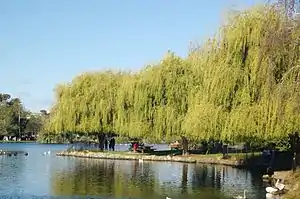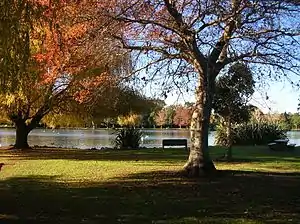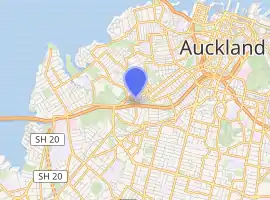Western Springs
Western Springs is a residential suburb and park in the city of Auckland in the north of New Zealand. It is located four kilometres to the west of the city centre, Auckland CBD. The park is situated to the north of State Highway 16 and the residential suburb is located southeast of the park on the opposite side of State Highway 16.
The suburb is dominated by the large park (featuring a lake with a variety of birdlife), within which are situated Auckland Zoo, Western Springs Stadium and M.O.T.A.T. (the Museum of Transport and Technology).[1] The park is the location of the annual Pasifika Festival, one of Auckland's most popular public events. Across the road from the zoo is the school of Western Springs College, with a student population of around 1705[2].
Suburb
Western Springs | |
|---|---|
Suburb | |
 Willows in Western Springs Park, looking east. | |

| |
| Country | New Zealand |
| Local authority | Auckland Council |
| Electoral ward | Waitematā and Gulf Ward |
| Population (2018) | |
| • Total | 3,099 |
| Point Chevalier | Westmere | Herne Bay |
| Point Chevalier |
|
Grey Lynn |
| Waterview | Morningside | Kingsland |
Demographics
| Year | Pop. | ±% p.a. |
|---|---|---|
| 2006 | 2,784 | — |
| 2013 | 3,039 | +1.26% |
| 2018 | 3,099 | +0.39% |
| Source: [3] | ||
The statistical area of Westmere South-Western Springs, which includes part of Westmere, had a population of 3,099 at the 2018 New Zealand census, an increase of 60 people (2.0%) since the 2013 census, and an increase of 315 people (11.3%) since the 2006 census. There were 1,074 households. There were 1,473 males and 1,629 females, giving a sex ratio of 0.9 males per female. The median age was 37.6 years, with 663 people (21.4%) aged under 15 years, 582 (18.8%) aged 15 to 29, 1,632 (52.7%) aged 30 to 64, and 225 (7.3%) aged 65 or older.
Ethnicities were 84.1% European/Pākehā, 11.6% Māori, 9.4% Pacific peoples, 6.4% Asian, and 3.2% other ethnicities (totals add to more than 100% since people could identify with multiple ethnicities).
The proportion of people born overseas was 23.3%, compared with 27.1% nationally.
Although some people objected to giving their religion, 62.7% had no religion, 27.5% were Christian, and 5.2% had other religions.
Of those at least 15 years old, 1,221 (50.1%) people had a bachelor or higher degree, and 159 (6.5%) people had no formal qualifications. The median income was $54,100. The employment status of those at least 15 was that 1,461 (60.0%) people were employed full-time, 408 (16.7%) were part-time, and 66 (2.7%) were unemployed.[3]
History
The Māori valued Waiorea (Western Springs) for the clean, clear spring water and eels that lived in the stream. After colonisation, the area was part of a block of land farmed by William Motion, a Scottish settler.[4]
The area was called Western Springs to differentiate it from the springs in the Auckland Domain to the east of the town. The main source of the water that feeds the lake at Western Springs is rain falling on the slopes of the volcanoes Te Tatua-a-Riukiuta, Mount Albert and Maungawhau / Mount Eden. The water runs underground for several miles through the lava flows, and emerges from the ground at a constant rate that is well filtered by the miles of scoria rocks.
As the city of Auckland grew, it found that well water was not sufficient. In the 1860s a pipe from the Domain Springs was constructed but in 1874 the city bought William Motion's mill and 120 acres (486,000 m2) of land including the spring. In 1875, the swampy ground was made into a 15-acre (6ha) artificial lake 6 feet in depth and capable of holding 22 million gallons of water. The scale of this work is revealed by the fact that Mr. Blewdon and his men removed 20,000 cartloads of spoil from the site and used 7,850 cubic yards of earth to construct the embankment which was 40 feet (12 m) wide at the base and 9 feet (2.7 m) wide at the crest. They also excavated the 25 feet (7.6 m) deep Engine Pond and dug a 60 feet (18 m) long tunnel between the lake and the Engine House.
A pumphouse was designed by City Engineer William Errington and built of brick. It was fitted with a steam engine, known as a beam engine, which is still in working order having been restored. The engine pumped water up to the two new reservoirs; one on the corner of Ponsonby Road and Karangahape Road and the other in the block bordered by Khyber Pass, Symonds Street, Mount Eden Road and Burleigh Street from where the water was gravity fed down to the city.
The cost of maintaining the pump was high however and by the end of the 19th century, Auckland's growth required a much greater and more reliable source of freshwater. This coincided with pressure to safeguard the remaining native forests of the Waitākere Ranges to the west of the city. Auckland City purchased land and built large reservoirs in this secluded area, thus safeguarding both the water quality and the flora & fauna of the area. The height of the reservoirs above sea level meant pumping was kept to a minimum as the water could be gravity fed down to town.
This left the Western Springs area with no specific use. The rough and uneven land was unsuitable for housing as apart from the lake it contained large stretches of boggy ground. Unable to divest itself of the land, the Auckland City Council was at a loss what to do with it. Some light industry and market gardens were developed along Great North Road and Chinamans hill [so-called because of the Chinese market gardeners] and an attempt was made to convert the boggy land around the lake into a park. However over the next thirty years or so most of the land deteriorated as it became overgrown and used for illegal rubbish dumping.
From the early 1920s onwards various developments took place; The Auckland City Council Zoological Gardens were established to the north of the lake. To the west (around the corner of Motions Road and Great North Road) a camping ground was set up (during World War II it was converted into a transit camp for American servicemen). To the south of the lake was established a golf club (Chamberlain Park) and to the west, land was set aside for primary, intermediate and secondary schools to service the growing suburbs of Westmere and Point Chevalier.
The council used some of the more usable land to construct council housing in the 1920s, and in the 1930s sold much of the land previously used for market gardens to the government for state housing. To the north of the zoo was an area of mangrove swamp where the Western Springs creek reached the sea near the Meola Reef lava outcrop. This was utilised as a landfill dump and hence reclaimed during the 1950s and 1960s. The reclaimed land was developed as playing fields and an additional area for the MOTAT Airfield, the Sir Keith Park Memorial Airfield (Motat 2), and is also the site of the Westpoint Performing Arts Center. In the 2000s the landfill was found to be emitting methane gas and was subsequently capped with clay.
After the war, the population of the surrounding suburbs grew markedly and it became obvious that the untidy state of Western Springs was an embarrassment. As a wilderness of bogs full of rubbish, rats and mosquitoes, it was not only unattractive but a potential health hazard. In 1961 the Auckland City Council embarked on developing the park in earnest. The lake, which had become completely choked by introduced waterweed was reclaimed and the overgrown landscape was carefully cleared of weeds and rubbish.
In 1953 a plan was put forward to use the area around the lake as an amusement park with a scenic railway, fairground and rollercoasters etc. but this was soon discovered to be beyond the financial capabilities of the Auckland City Council.
In 1964 the Museum of Transport and Technology (MOTAT) was established to the south east of the lake, the old pumphouse forming its centrepiece.
By the 1980s major landscaping work had transformed the area from an eyesore to being one of Auckland's most attractive parks. New plantings were introduced to complement the mature trees from the 19th century and careful planting of the islands of the lake and the wetlands surrounding it have made it a successful breeding ground for a large variety of waterfowl both native and exotic. Artworks by several New Zealand sculptors were sited in the park during the 1980s and 1990s.
International music artists that have performed at Western Springs Stadium include Led Zeppelin, Slade, Status Quo, Elton John, Rod Stewart, David Bowie, Fleetwood Mac, KISS, Bob Marley & The Wailers, Dire Straits, AC/DC, Eurythmics, Pink Floyd, Jerry Lee Lewis, U2, Big Audio Dynamite, Mick Jagger, Guns N' Roses, Paul McCartney, The Eagles, Red Hot Chili Peppers, The Rolling Stones, Robbie Williams, The Police & The Black Eyed Peas, among others.
Education
Western Springs College is a coeducational high school (years 9-13) with a roll of 1705 as of March 2020.[2][5]
Park
| Western Springs | |
|---|---|
 A view of the lake in Western Springs Park. | |

| |
| Type | Public park |
| Location | Auckland, New Zealand |
| Area | 64 acres (0.26 km2) |
| Created | 1980s |
| Operated by | Auckland Council |
| Status | Open year round |
Western Springs Park consists of a sanctuary for wildlife, surrounding a lake fed by the natural springs. There are walking paths surrounding the lake with bridges going across sections of it. Auckland Zoo, MOTAT and Western Springs Stadium are all situated around the park.
Plants
There are a number of different plant species found in Western Springs Park, including:
Native
Introduced
Facilities
There are a wide variety of facilities in the park, including:
- Barbecues
- Drinking fountains
- Picnic tables
- Playground
Water birds
Western Springs Park has a wide variety of water birds, both native and introduced. Some of the water bird species that can be found in park include:
- Pied shag or karuhiruhi (locally common native)
- Little shag or kawaupaka (common native)
- New Zealand scaup or papango (uncommon endemic)
- New Zealand dabchick or weweia (uncommon endemic)
- Pukeko or purple swamp hen (abundant native)
- Australian coot (locally common native)
- Mallard duck (abundant European introduction)
- Domestic goose (common European introduction)
- Black swan (common Australian introduction)
- Grey duck or parera (common native)
- Paradise shelduck or putangitangi (common endemic)
- Red billed gull or tarapunga (abundant native)
- Black-backed gull or karoro (abundant native)
- Black-billed gull or tarapuka (locally common endemic)
Fish
There are a significant number of eels in the park, which is reflected in the lake's Maori name: 'Te Wai Orea' (The water of the eels). The lake contains New Zealand's native species of eel: the shortfin (Anguilla australis) and longfin (Anguilla dieffenbachii). The long-finned eel has been identified as a species that is in decline and could become extinct within the next 50 years.[6]
Fishing is illegal in the lake and is punishable by fines.[6]
There a number of fish species:
Native:
Introduced:
See also
References
- Notes
- "Auckland Parks". Jasons Travel Media.
- "New Zealand Schools Directory". New Zealand Ministry of Education. Retrieved 26 April 2020.
- "Statistical area 1 dataset for 2018 Census". Statistics New Zealand. March 2020. Westmere South-Western Springs (130300). 2018 Census place summary: Westmere South-Western Springs
- "Streets: Motions Road". Auckland Museum. Retrieved 22 December 2012.
- Education Counts: Western Springs College
- "Western Springs Park". Auckland Council. Retrieved 11 December 2013.
- Bibliography
- Decently And In Order, The Centennial History Of The Auckland City Council. G.W.A.Bush. Collins 1971
- The Beam Engine & Western Springs Pumping Station published by MOTAT 2008
External links
- Photographs of Western Springs held in Auckland Libraries' heritage collections.